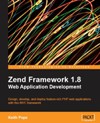Archive for December 2009
30
PyDumpy - Partial sorted MySQL database dumps
0 Comments | Posted by Žilvinas Šaltys in MySQL, Tools
is a simple Python utility that might be helpful for developers struggling to get fast and partial database snapshots from production databases. It does it’s job by checking the database information schema to find out the approximate rows count available in each table and limits the table if needed to avoid dumping too much data as some databases may have hundreds of gigabytes of data. It then passes all the limits information it gathers to mysqldump a tool created by MySQL to do the actual dumping.
Python does not have a built in package to connect to MySQL as for example PHP does and therefore PyDumpy relies on MySQL for Python package to work. PyDumpy also relies on mysqladmin to do the actual dumping.
PyDumpy is very simple to use. For example to dump a maximum of 50 000 rows from each table type:
./pydumpy.py -H host -u user -p pass -n dbname -limit=50000
PyDumpy also allows to specify row limits and sorting preferences for each table specifically:
./pydumpy.py -H host -u user -p pass -n dbname -limit=50000 -ask-to-limit -ask-to-sort
If you find this tool useful please feel free to provide feedback by leaving a comment.
9
Spring Persistence with Hibernate
0 Comments | Posted by Žilvinas Šaltys in Books, Frameworks, Reviews
 It seems that I will continue reviewing books for Packt publishing. Spring Persistence with Hibernate is a book about a different development world. Spring web development framework and Hibernate persistence framework are both well known Java technologies. Even though I have little to do with Java I believe it has a great world wide community of software development experts. Not surprisingly lot’s of innovation comes from the Java world. I believe it is because Java developers know a lot more about proper design principles and coding practices than an average developer of let’s say PHP or .NET.
It seems that I will continue reviewing books for Packt publishing. Spring Persistence with Hibernate is a book about a different development world. Spring web development framework and Hibernate persistence framework are both well known Java technologies. Even though I have little to do with Java I believe it has a great world wide community of software development experts. Not surprisingly lot’s of innovation comes from the Java world. I believe it is because Java developers know a lot more about proper design principles and coding practices than an average developer of let’s say PHP or .NET.
This book should cover such topics as getting a grip with hibernate, integrating hibernate with spring, spring IoC, spring AOP, transaction management, unit testing. I believe it will be a worthwhile read with high hopes that it will give me new ideas what I could implement or use in the PHP world.
9
Zend Framework 1.8 Web Application Development Review
1 Comment | Posted by Žilvinas Šaltys in Books, Frameworks, Optimization, PHP, Reviews
 As I mentioned earlier guys from Packt publishing asked me to review a recently published book Zend Framework 1.8 Web Application Development. The title says it all - it’s a book about designing and developing PHP web applications using Zend framework.
As I mentioned earlier guys from Packt publishing asked me to review a recently published book Zend Framework 1.8 Web Application Development. The title says it all - it’s a book about designing and developing PHP web applications using Zend framework.
This book doesn’t require the reader to be familiar with zend framework and explains all concepts in proper detail, though it will be easier to read the book if the reader is familiar with the framework and/or has experience with MVC and OOP in general. This book should be interesting to all developers who design and develop day to day web applications using MVC frameworks or not yet familiar with them as it may improve their insights towards web applications modelling, testing , optimizations and more.
Even though I am fairly familiar with the framework I found the book to be an interesting, easy read, plentiful of examples explaining the intricacies of the framework.
The first though a very important chapter teaches the concept of bootstrapping using Zend_Application and shows how to write and run a simple hello world program using controllers and views. As well it introduces the use of controller utility methods such as _getParam(), _forward(), _redirect(), action helpers, view helpers which are very valuable and a lot of developers miss them entirely. This chapter also shows the proper use of the response object which also tends to get forgotten.
The second chapter dives straight into the Front Controller pattern explaining how the framework routes, dispatches requests and responds to the client. I have never been bothered to understand the whole thing and was quite surprised to see how simple it all is. It is worth mentioning that this chapter explains in great detail how the router and various routes work and how elegantly it integrates with Zend_Config. Last the chapter covers the request object and it’s external API which provides lot’s of valuable functionality.
From the third chapter author Keith Pope starts building the main application of the entire book, the Storefront. It’s a relatively simple “real life” application that serves the purpose of being an online products catalog. This chapter shows how such an application is structured on a file system and bootstrapped and configured. Even more the chapter covers the creation of Zend_Log and various logging writers and database profiling. Extremely valuable features that not many developers know of. If every zend framework application would start as the chapter describes I believe a lot more developers would be eager to start their IDE’s 9:00 AM straight.
Next is my personal favorite chapter - Models. Zend Framework does not have a base Model class and there’s a pretty good reason why it doesn’t. Models are specialized for a certain business task and as such it is arguably impossible to make a generic model implementation that would fit all sizes well. It then might raise a question what’s there to read about? It is my personal belief that web applications modelling has lost focus during the years by the ever growing development community. Developers got their minds focused on the next “new” thing. Let it be template engines, ORM’s, rise of active record and ruby on rails, ajax and javascript frameworks. While the majority of the models “out there” are deeply crippled. Hundreds of books were written explaining how to manage the complexity of the problem so a single chapter is a mighty challenge. I believe the author made a great choice by explaining the concept of the fat model, skinny controller, explaining the benefits composition over inheritance, data access layer separation from the business layer and my deepest respect for introducing domain model design, Martin Fowler’s book Patterns of Enterprise Application and Eric Evan’s book Domain Driven Design also known as DDD.
Next five chapters describe the implementation of the Storefront application. Each chapter highlights a major component of the framework. Use of resource autoloaders, plugins, Zend_Form, Zend_Auth, Zend_Acl. Before saying anything else it is very important to say that books rarely ever show hardcore “real life” applications as examples. Even Fowler himself likes to skip certain topics like validation in certain sections of his famous book just because they complicate things too much. This book is no exception to the rule. It’s a pretty straightforward application. There isn’t a single join to another table or a GROUP BY statement in SQL, forms implemented with Zend_Form are rather simple with little if any javascript / ajax. I found it a bit disturbing that class create other classes having both business and factory logic. One of the ugly examples was where a getPrice() method on a product model creates it’s own Taxation service which could not be mocked if that class would need to be unit tested. In most of the cases author provides injection methods for unit testing but I would argue that it does not show class dependencies explicitly which is very valuable for unit testing. Besides that I really enjoyed how the author decided to go with ACL in the domain layer. This would more often than not be implemented in the controllers making the model tightly dependent on the controllers. All in all keeping in mind that it’s a tutorial application introducing the framework I’m highly satisfied of it’s overall quality. Repeating myself. If every zend framework application would be so well written..
Another chapter worth mentioning is regarding optimizations. I was surprised to learn about such things like plugin loader cache, table gateway metadata or various Zend_Cache frontends which I have never bothered to look up. Not to mention widely known tricks using APC, stripping zend framework of all requires and setting up an optimized include path.
And last but not least again one of my favorite topics - testing. I strongly agree with Misko Hevery that test driven development is a skill. It’s definitely not easy to start or learn. One would fool himself to think otherwise. This topic deserves many books of it’s own. I can only share from my own experience - once I started unit testing applications that I work with, I have never looked back. This chapter explains different types of testing, shows how to setup PHPUnit and provides examples of controller testing using Zend_Test. I believe this chapter deserves more attention on how to do testing with a database in mind, debugging failing controllers, avoiding complicated mocks, implementing continuous integration. But again it is worth to keep in mind that the book is about Zend Framework and not testing in general.
All in all I enjoyed reading this book. I would and will recommend it to my colleagues and friends. I hope that this hopefully not too boring review convinced you to buy the book and learn something new. Once again - big thanks to Packt Publishing for a free book. Happy reading. Over and out.
